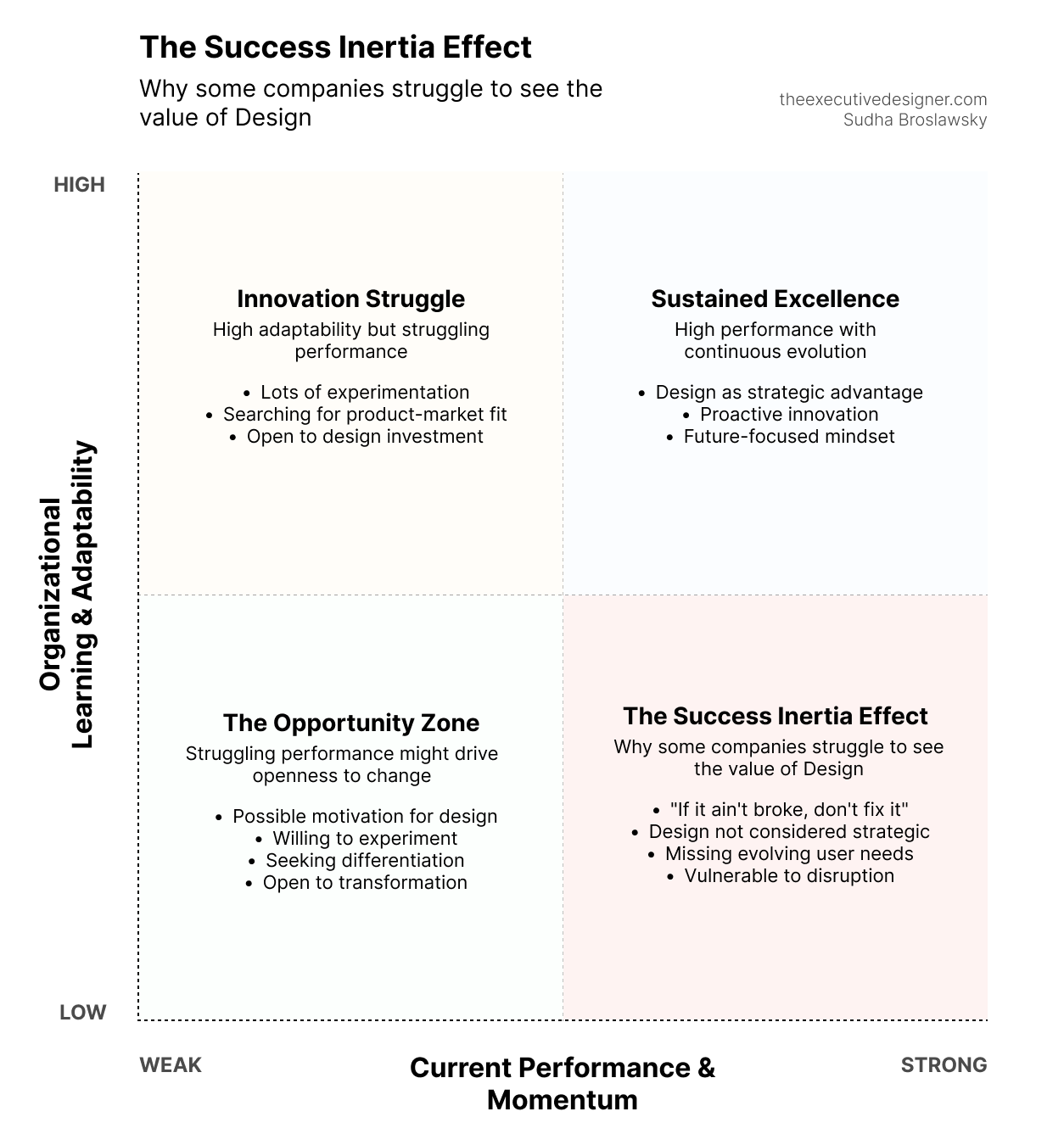The Success Inertia Effect: Why Some Companies Struggle to See the Value of Design
Note: This post explores a pattern I've observed throughout my career working with established companies that have become victims of their own success. If you've ever wondered why some businesses seem resistant to design investment despite having the resources, this framework might help explain what's happening and what we can do about it.
"If it ain't broke, why fix it?"
I can't tell you how many times I've heard this phrase in executive and strategy meetings. For many companies that have enjoyed sustained success, this becomes more than just a saying; it becomes a dangerous business philosophy. And let's face it, it can also feel like handcuffs, especially for design leaders trying to drive transformation.
I remember sitting in a quarterly business review at a company that had been a market leader for over fifteen years. The numbers looked good; customer acquisition was steady, revenue was growing, the economic tailwinds were helping, and leadership was celebrating another successful quarter. When my team and I presented research showing that customer satisfaction scores were declining and competitors were gaining ground with more intuitive experiences, the response was immediate: "But our customers are still choosing us, so clearly what we're doing is working."
That moment crystallized something I'd been seeing across multiple organizations. Companies weren't just resistant to change; they were actively choosing not to see the signals that change was necessary.
Over the years, I've worked with companies that experienced their "good times" — periods when everything seemed to be working smoothly. Customers were coming in, revenue was solid, and the business model felt validated.
And yet, I noticed something counterintuitive that kept me thinking.
Even as these businesses celebrated their past successes and coasted on established momentum, design was consistently under-prioritized. Not because people didn't care about their users or the experience, but because it was genuinely not a priority to see what needed fixing (or rethinking) when the company believed it was still riding the wave of previous wins.
When past success creates future blind spots
Companies that have consistently enjoyed success often believe they've cracked the code. They had their moment. Maybe it was being first to market, nailing a particular customer segment, or building something that really resonated at the right time. The problem is that they assume the formula will work indefinitely.
But I've learned that this creates a dangerous blind spot. When businesses continue to operate based on what worked in their heyday, they stop actively listening to the real signals around them. They overlook the fact that customer needs are evolving, competitors are emerging with better solutions, and market conditions are shifting beneath their feet.
The human cost of this is significant. I've watched talented designers and researchers leave organizations because their insights were consistently dismissed as "nice to have" rather than strategically important. Teams become demoralized when they see clear opportunities for improvement but can't get buy-in to address them. Meanwhile, customers start experiencing friction that goes unaddressed, leading to the slow erosion of loyalty that doesn't show up in quarterly reports until it's too late.
Meanwhile, design becomes a "nice-to-have" rather than a strategic necessity. The company genuinely believes they're still benefiting from their previous success, completely overlooking the potential for design to help them:
Recognize and respond to evolving customer expectations
Stay ahead of emerging competitive threats
Identify new growth opportunities in changing markets
Build the adaptability needed to thrive in different conditions
In these contexts, investment in design feels unnecessary because leadership doesn't see the cracks forming in their foundation.
The pattern I kept seeing
As I reflected on this challenge, I realized there was a deeper pattern at play. These companies weren't just resting on their laurels; they had become victims of their own success. We're talking about businesses that had found something that worked really well, often years or even decades ago, and had built entire organizational identities around that success.
This created what I started thinking of as a potent combination: Legacy success + Present Momentum + Future blindness.
Legacy success: They had proven formulas and established ways of doing things that had delivered results in the past.
Present momentum: They were still generating revenue and meeting targets, creating the illusion that everything was fine.
Future blindness: They weren't actively scanning for changes in their environment or disrupting themselves before someone else did.
I call this the Success Inertia Effect, and once I started looking for it, I saw it everywhere.
Is your company experiencing the Success Inertia Effect? Five warning signs
If you're wondering whether your organization might be stuck in this pattern, here are the signals I've learned to watch for:
1. "Our customers haven't complained" is used as evidence that everything is fine. This usually means the company isn't actively seeking feedback or has made it difficult for customers to provide it.
2. Competitive analysis focuses only on direct competitors, not companies solving similar problems differently. When teams only look at others doing exactly what they do, they miss entirely the disruptive approaches that could benefit them.
3. Success metrics haven't evolved in years. Companies experiencing this effect continue to measure what made them successful in the past, rather than what will make them successful in the future.
4. New ideas are consistently met with "we tried that before" or "that's not how we do things here." This shows the organization has stopped learning from both failures and changing contexts.
5. Design and research insights are treated as opinions rather than data. When qualitative insights about user needs are dismissed or not taken seriously because they don't align with existing assumptions, it's a clear sign of the effect taking hold.
Visualizing the effect
To help myself (and others) understand this dynamic better, I developed a simple framework that maps companies along two key dimensions:
Organizational Learning & Adaptability (High vs. Low)
Current Performance & Momentum (Strong vs. Weak)
Companies in what I think of as the "inertia zone," those with strong current performance but low adaptability, are coasting on past success while missing critical signals about their future. That very momentum can blind them to some critical realities:
Customer needs that have evolved since their initial success
New competitors who are solving problems in fundamentally different ways
Market shifts that make their original advantages less relevant
Internal processes and systems that worked then but create friction now
Compare this to companies that might be struggling with current performance but are highly adaptable. These companies often see design as essential for reinvention and invest in understanding their changing landscape as a survival strategy.
The stakes are higher than you think
I've seen what happens when companies wait too long to address this effect. One organization I worked with spent three years not prioritizing user research showing their user experience was becoming outdated. They pointed to stable customer numbers as proof they were fine. But when a competitor launched with a significantly better user experience, customer defection happened rapidly — within six months, they lost 30% of their user base to the new entrant.
The reality is that customer loyalty built on past success can evaporate quickly when better alternatives emerge. And in today's market, those alternatives are emerging faster than ever.
What this means for design leaders
If you find yourself facing these challenges within your organization, I've learned a few strategies that can help:
Make the invisible visible. These companies aren't ignoring signals on purpose — they genuinely don't see them. Document the gaps between what customers actually need today versus what the company thinks they need. Use research to expose evolving expectations and pain points that might not show up in traditional business metrics.
One approach that's worked for me is creating "day in the life" journey maps that show the cumulative friction customers experience. When you present these alongside competitive experiences that solve the same problems more elegantly, it becomes harder to dismiss the need for change.
Reframe design as future-proofing. Instead of positioning design as fixing what's broken, position it as ensuring continued success. I've had success showing how design visioning and thinking help companies stay ahead of shifts rather than react to them after it's too late.
Try language like: "Our success gives us the opportunity to evolve from a position of strength rather than react from a position of necessity."
Connect the dots to competitive threats. Find examples of companies in adjacent markets or with similar customer bases who have been disrupted by more design-forward competitors. Sometimes, seeing what happened to others in similar situations is the wake-up call leadership needs.
I always recommend focusing on companies that were similarly successful before being disrupted, as it makes the threat feel more real and immediate.
Build allies across the organization. You can't fight this battle alone. Build allies in sales, customer service, marketing, or product management who are also close to the customer and who hear things directly, to support and add to your insights. When multiple departments start raising similar concerns, it becomes harder to dismiss them as isolated opinions.
Start with small wins that build credibility. Pick one area where you can demonstrate clear impact without requiring massive organizational change. Once you've proven value in a contained way, you'll have more leverage to tackle bigger systemic challenges.
Focus on improvements that have a measurable business impact, such as reduced support tickets, increased conversion rates, or improved task completion times.
The bigger picture
Not all successful companies suffer from this — I want to be clear about that. But those that do often share one thing: they're so focused on preserving what made them successful that they stop actively working to understand what will make them successful in the future.
As design leaders, I believe we have a unique opportunity to help these organizations develop what I think of as "success radar": the ability to sense when conditions are changing and adapt accordingly. Design, at its core, is about staying connected to human needs and finding creative solutions to evolving problems.
The truth is, what made a company successful five years ago might not be what makes it successful tomorrow. Customer expectations evolve. Markets shift. New solutions emerge. The companies that recognize this and invest in design as a strategic capability, not just a service function, are the ones that will continue to thrive when their original advantages are no longer enough.
What I've learned is that overcoming the Success Inertia Effect isn't just about proving design's value; it's about helping our organizations develop the humility to question their own success and the courage to evolve before they have to.
The most successful design leaders I know aren't just advocating for better experiences; they're helping their companies build the organizational muscle to continuously evolve. That's the difference between companies that sustain success over decades and those that become cautionary tales about what happens when you stop listening to the world around you.
Have you encountered this pattern in your own work? I'd love to hear about your experiences helping organizations move beyond the comfort of past success. A note until next time: sometimes the biggest risk to future success is being too attached to what worked in the past.





Remove the ‘Fluff’ was the comment I got when I asked to do a discovery session for a redesign initiative
I continued to build the as-is vs to-be journey map
First they were skeptical about the value
And as they saw the new onboarding plus the last steps loop/iterative process depicted correctly for a B2B process
The confidence in the outcomes got better
Thanks for sharing the story Sudha